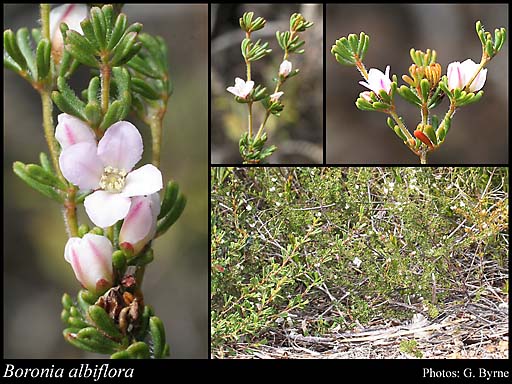- Reference
- Fl.Austral. 1:317 (1863)
- Conservation Code
- Not threatened
- Naturalised Status
- Native to Western Australia
- Name Status
- Current
Erect, soft shrub, 0.1-0.7(-1.5) m high. Fl. pink/pink-white, Jan to Dec. Often sandy soils.

Scientific Description
Shrub, spines absent; branchlets smooth, without distinct raised glands, +/- cylindrical in cross-section, covered in hairs or scales. Leaves opposite, compound, 6.5-7.5 mm long, with 3-5 leaflets, each 4-4.5 mm long, 1-1.2 mm wide, flat, the margins flat, smooth, without distinct raised glands, glabrous; stipular excrescences absent. Flowers axillary, solitary; pedicels 1-2 mm long; calyx present, 2.5-3 mm long, smooth, without distinct raised glands, glabrous; corolla pink or white or cream, petals four, 6-7 mm long, imbricate (overlapping), free, glabrous; stamens twice as many as petals, 2 mm long, smooth, ciliate (with a marginal fringe of hairs); anthers 0.2-0.5 mm long, with an appendage. Flowers in January, February, March, April, May, June, July, August, September, October, November and December. Occurs in the South-West Botanical Province, in the Avon Wheatbelt, Jarrah Forest, Mallee and Esperance IBRA region(s).
Distribution
- IBRA Regions
- Avon Wheatbelt, Esperance Plains, Jarrah Forest, Mallee.
- IBRA Subregions
- Eastern Mallee, Fitzgerald, Katanning, Recherche, Southern Jarrah Forest.
- IMCRA Regions
- WA South Coast.
- Local Government Areas (LGAs)
- Albany, Cranbrook, Esperance, Gnowangerup, Jerramungup, Plantagenet, Ravensthorpe.